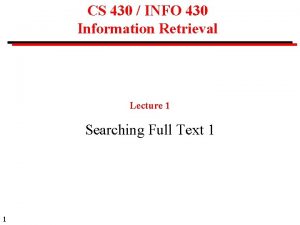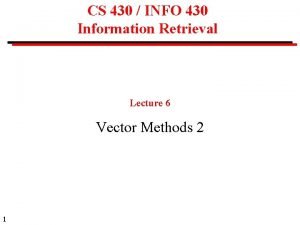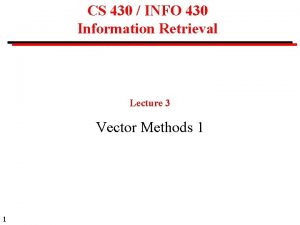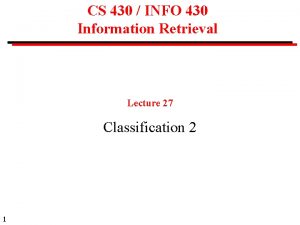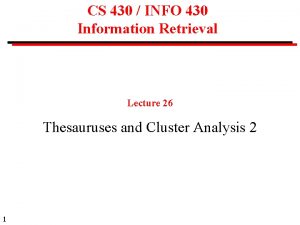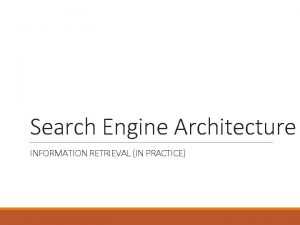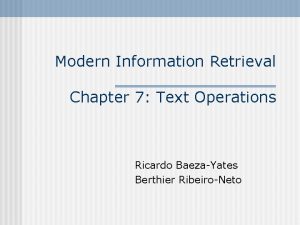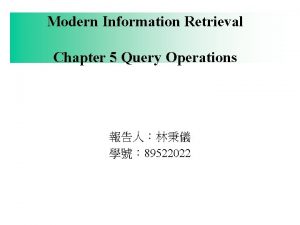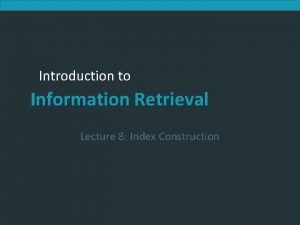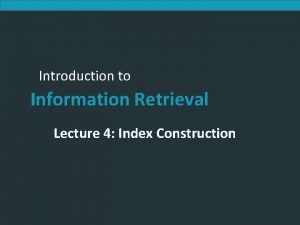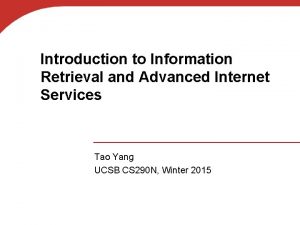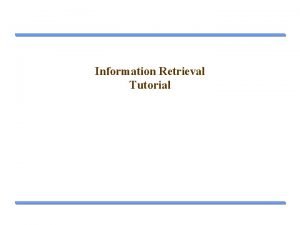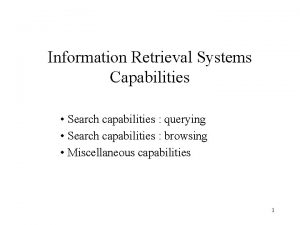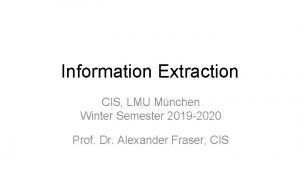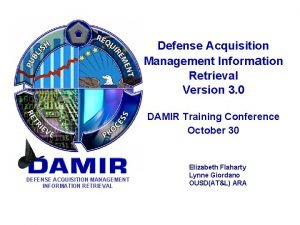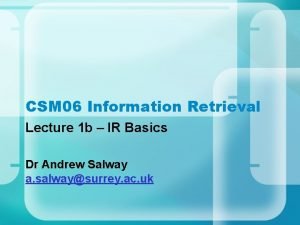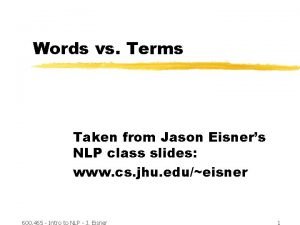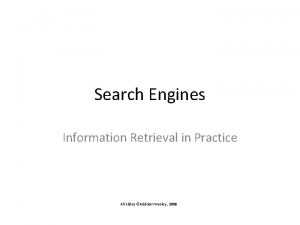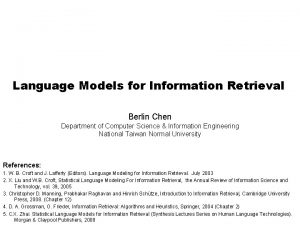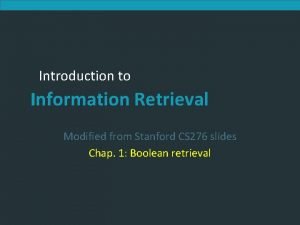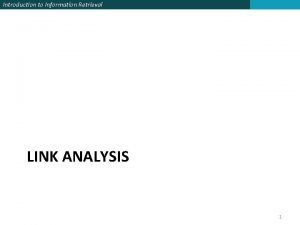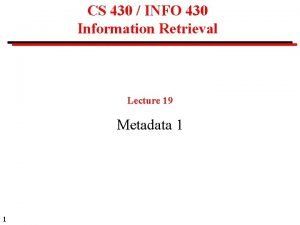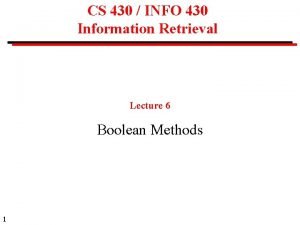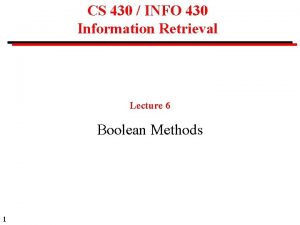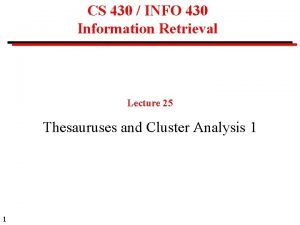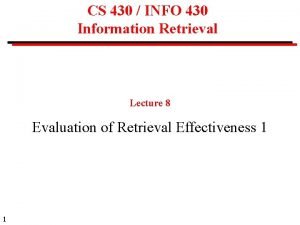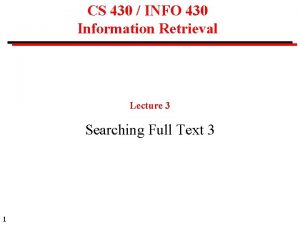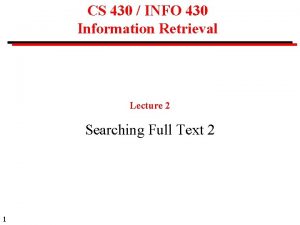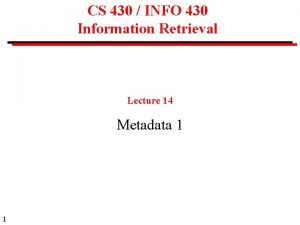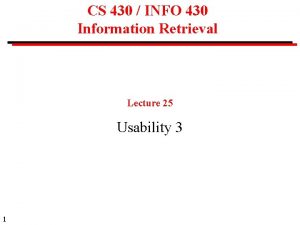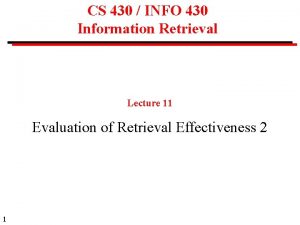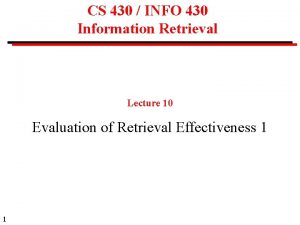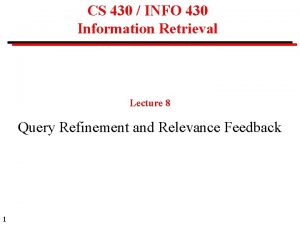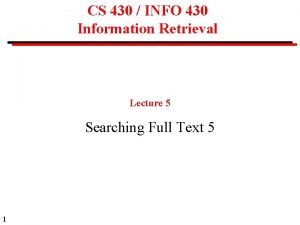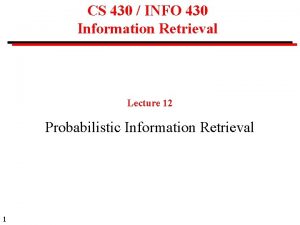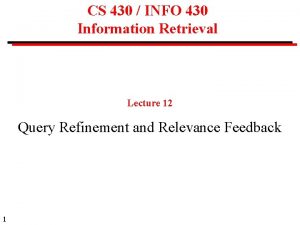CS 430 INFO 430 Information Retrieval Lecture 13




























- Slides: 28

CS 430 / INFO 430 Information Retrieval Lecture 13 Architecture of Information Retrieval Systems 1

Course Administration Assignment 2 Deadline changed to midnight on Sunday, October 9 There is major electrical work in Upson Hall on Saturday and most of the computers and labs will not be available. 2

Course Administration Midterm Examination Wednesday, October 12, 7: 30 to 9: 00, Upson B 17 The topics to be are examined are all lectures and discussion class readings before the midterm break. See the Web site for a sample paper from a previous year. See the Web site for instructions about laptop computers. 3

Course Administration Discussion Class on October 19 This class will be held in Philips Hall 213 4

Notation Documents file Docs File of catalog records Catalog User interface Human action Physical objects User interface service UI 5 Searchable index Index Automatic process

Single Homogeneous Collection: Full Text Indexing • Documents and indexes are held on a single computer system (may be several computers). • Information retrieval uses a full text index, which may be tuned to the specific corpus. Build index Search Index Examples: SMART, Lucene 6 Docs

Single Homogeneous Collection: Use of Catalog Records • Documents may be digital or physical objects, e. g. , books. • Documents are described by catalog records generated manually (or sometimes automatically). • Information retrieval uses an index of catalog records Build index Search Index Example: Library catalog 7 Create catalog Catalog Docs

Several Similar Collections: One Computer System • Several more or less similar collections are held on a single computer system. • Each collection is indexed separately using the same software, procedures, algorithms, etc. (but tuned for each collection, e. g. , different stoplists). Build indexes Search Index Example: Pub. Med 8 Docs

Distributed Architecture: Standard Search Protocols Index 1 Index 2 9 Strict adherence to standards allows any user interface to search any conforming search service.

Standard Search Protocols Example: Z 39. 50 Family of Standards for Searching Library Catalogs The Z 39. 50 family of standards has proved successful in a tightly knit community, where: • There is a strong tradition of standardization, with many professionally trained people. • The categories of material change gradually, allowing a slow-moving standardization process. The standardization approach has failed where these two criteria are not met. Historic note: WAIS was based on an early version of Z 39. 50. 10

Z 39. 50 principles • Servers store a set of databases with searchable indexes • Interactions are based on a session • The client opens a connection with the server(s), carries out a sequence of interactions and then closes the connection. • During the course of the session, both the server and the client remember the state of their interaction. 11

State Z 39. 50 • The server carries out the search and builds a results set • Server saves the results set. • Subsequent message from the client can reference the result set. • Thus the client can modify a large set by increasingly precise requests, or can request a presentation of any record in the set, without searching entire database. 12

Standards Z 39. 50 Family of Standards for Searching Library Catalogs Content: Anglo American Cataloging Rules Structure of Content: MARC Encoding Rules: Base Encoding Rules (character sets, separators, etc. ) Message Passing Protocol: Z 39. 50 Query Format: Bib 1 (Boolean), Type 102 (full text) In addition, there are the underlying network standards, e. g. the Internet suite of protocols. 13

Distributed Architecture: Meta-search (Broadcast Search) • A user interface service broadcasts a query to several indexes and merges the results. • Can be used with full text or catalogs. Searches Index 1 Search UI User interface service Index 2 Index n Example: Dienst 14

Distributed Architecture: Broadcast Search Interface Service: Can be a separate server (e. g. , CGI), or run on the user's computer (e. g. , applet). Protocols: In the simple version, each collection must support the same standards and protocols (e. g. , Z 39. 50, http). 15

Distributed Architecture: Broadcast Search Problems with Broadcast Search • Performance: If any collection does not respond, the Interface Server waits for a time out. • Recall: If any collection does not respond, documents in that collection are not found. • Ranking and duplicates: There are great difficulties in reconciling ranked lists from different collections. Broadcast searching is as bad as its weakest link! Conclusion: Broadcast search does not scale beyond about five or ten collections, even with strict standardization. 16

Union Catalog • Catalog records from several libraries are merged into a single union catalog • Information retrieval uses an index of the records in the union catalog Create catalog records Build Docs index Search Index to Union Catalog Example: Harvard University's Hollis system 17 Docs

Use of Union Catalogs Search Index to Union Catalog Retrieve Union Catalog Docs 18 Docs Batch indexing: Metadata about all items is accumulated in a central system. Real-time searching: The user (a) searches the central index, (b) retrieves catalog records, (c) retrieves documents from collections.

Building Union Catalogs Harvesting • Each collection makes a copy of its metadata (catalog records) available from a sever associated with the collection. • A search service harvests metadata from all collections on a regular cycle and builds a central search system. Advantages. . . • Can index material from databases without explicit URLs. • Allows authentication and selection of material. but. . . 19 • Requires that collections have metadata and support harvesting protocol (e. g. , Open Archives Initiative Protocol for Metadata Harvesting).

OAI Verbs • • • 20 Identify – repository characteristics List. Metadata. Formats – DC required List. Sets – repository partitioning List. Records – (selectively) harvest metadata List. Identifiers – (selectively) harvest metadata identifiers Get. Record – known item retrieval

OAI-PMH Key technical features • • • 21 Simple HTTP encoding Built on of established XML standards Multiple metadata formats, but Dublin Core required Repository partitioning (sets) Selective harvesting (sets and dates) Clean partition between core and implementation-specific extensions – Multiple item-level metadata – Collection level metadata

Open Archives Initiative Protocol for Metadata Harvesting See: http: //www. openarchives. org/ Herbert Van de Sompel and Carl Lagoze, "The Santa Fe Convention of the Open Archives Initiative. " D-Lib Magazine, 6(2), 2000 http: //www. dlib. org/dlib/february 00/vandesompeloai/02 vandesompel-oai. html 22

Web Searching: Architecture • Documents stored on many Web servers are indexed in a single central index. (This is similar to a union catalog. ) • The central index is implemented as a single system on a very large number of computers Build index Docs Search on Web Index to all Web pages Examples: Google, Yahoo! 23 server Docs on Web server

Use of Web Search Service Search Index to all Web pages Retrieve Docs on Web server 24 Batch indexing: Each Web page is brought to the central location and indexed. Real-time searching: The user (a) searches the central index, (b) retrieves documents (Web pages) from original location.

Web Searching: Building the Index Documents are Web pages Each document is: • identified by Web Crawling • copied to a central location • indexed and added to the central index After indexing the documents are usually discarded, but a cached copy may be retained. Web searching is the topic of Lectures 19 -21 and Discussion Classes 9 and 10. 25

Web Crawling Advantages of Web crawling • Entirely automatic, low cost. Highly efficient at gathering very large amounts of material. but. . . • Can only gather openly accessible materials. • Cannot gather material in databases unless explicit URLs are known. • Cannot easily make use of metadata provided by collections. 26

Standardization: Function Versus Cost of Acceptance Cost of acceptance Few adopters Many adopters 27 Function

Example: Textual Mark-up Cost of acceptance SGML XML HTML ASCII 28 Function
 Info 430
Info 430 Fijtimes
Fijtimes Info 430
Info 430 Info 430
Info 430 Info 430
Info 430 Cluster foxtrots
Cluster foxtrots 01:640:244 lecture notes - lecture 15: plat, idah, farad
01:640:244 lecture notes - lecture 15: plat, idah, farad Sequential searching
Sequential searching Search engine architecture in information retrieval
Search engine architecture in information retrieval What is precision and recall in information retrieval
What is precision and recall in information retrieval Text operations in information retrieval
Text operations in information retrieval Query operations in information retrieval
Query operations in information retrieval Positional index information retrieval
Positional index information retrieval Index construction in information retrieval
Index construction in information retrieval Bsbi vs spimi
Bsbi vs spimi Which internet service is used for information retrieval
Which internet service is used for information retrieval Information retrieval tutorial
Information retrieval tutorial Wild card queries in information retrieval
Wild card queries in information retrieval Capabilities of information retrieval system
Capabilities of information retrieval system Link analysis in information retrieval
Link analysis in information retrieval Information retrieval lmu
Information retrieval lmu Defense acquisition management information retrieval
Defense acquisition management information retrieval Advantages of information retrieval system
Advantages of information retrieval system Information retrieval nlp
Information retrieval nlp Signature file structure in information retrieval system
Signature file structure in information retrieval system Information retrieval slides
Information retrieval slides Relevance information retrieval
Relevance information retrieval Information retrieval stanford
Information retrieval stanford Link analysis in information retrieval
Link analysis in information retrieval
